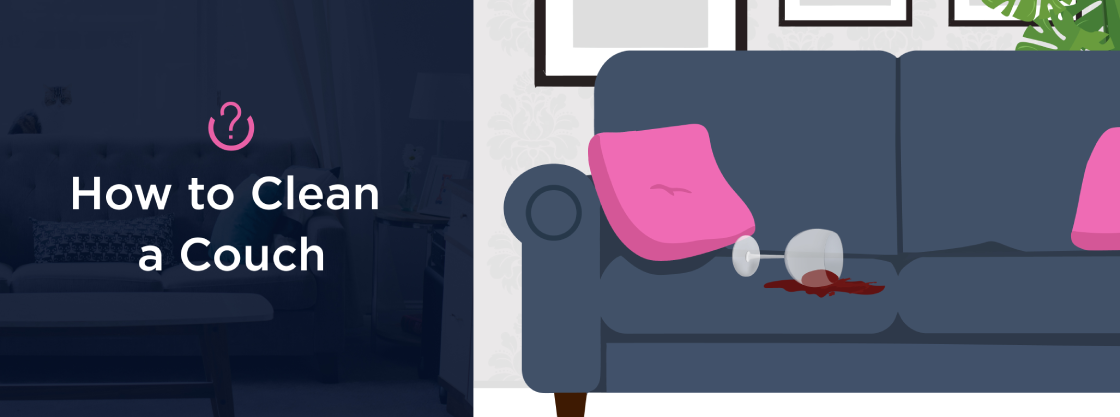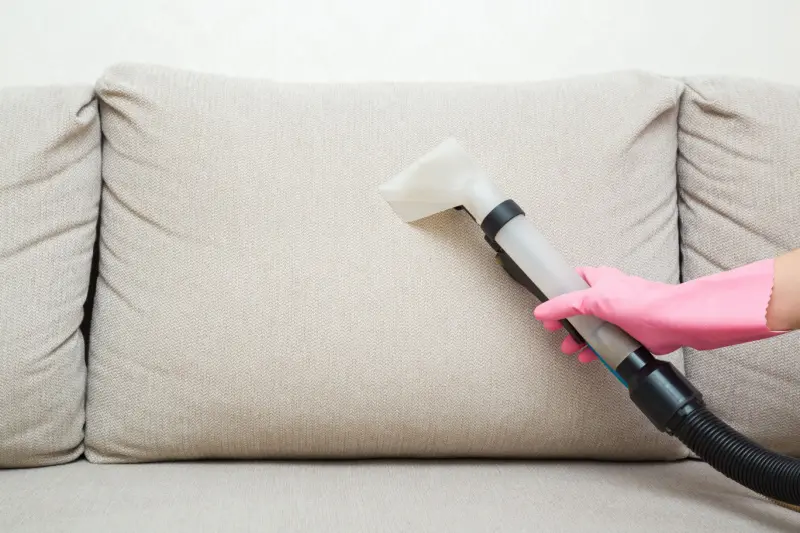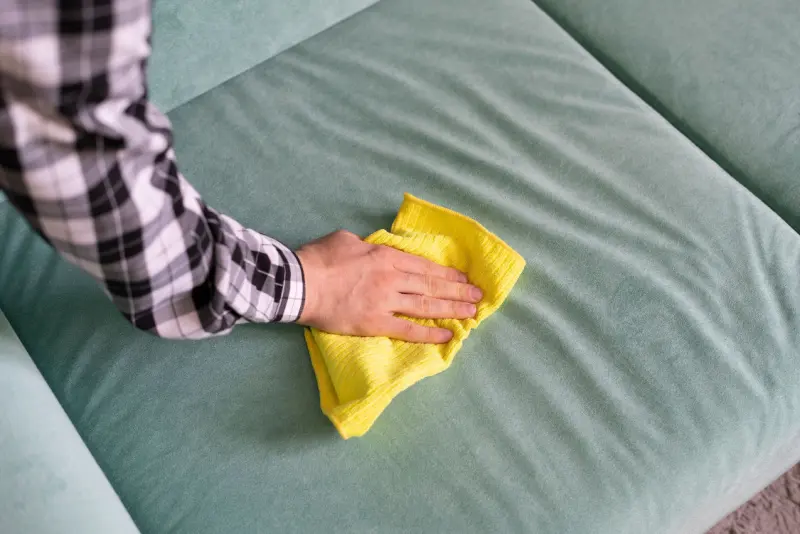
Molly Maid pros offer expert guidance on removing couch stains effectively.
|
Couches get a lot of use, and along with it, an accumulation of dirt and stains. Therefore, knowing how to clean a couch is a necessary skill. Whether you want to know how to clean up an emergency red wine spill or a buildup of everyday dirt, read on as we share our best professional couch-cleaning tips.
Cleaning Different Types of Couches
Before you even gather cleaning supplies, determine your couch’s material. Different couch materials, such as leather, microfiber, and cotton, require different cleaning methods, or else you can cause permanent stains or damage. Durable and stain-resistant leather needs a gentle cleaner and conditioner. Microfiber, popular for its softness and resistance to stains and moisture, typically requires water-based cleaning solutions. Cotton is comfortable but prone to stains and often needs professional cleaning.
Depending on the material, gather supplies such as mild detergent, a soft brush, and a microfiber cloth tailored to the type of stain and fabric. Always check the manufacturer's guidelines for specific care instructions to avoid damage. This approach is key to cleaning a couch effectively and safely.
Couches always have cleaning tags. Check them for instructions. The following are codes you may find and their meanings:
- W – You can use water to clean this fabric.
- S – Do not use water. You must use a solvent-based cleaner on this fabric instead.
- WS – You may use water or a solvent-based cleaner on this material.
- X – Only vacuum this material.
Check the care tag before attempting to clean your couch, and always test products in a small, unnoticeable spot before applying them to the whole couch.
How to Clean a Fabric Couch
- Start with a deodorizing baking soda clean. Prep the couch by brushing it with a clean white hand towel or a stiff brush. This will loosen anything that has dried onto the couch.
- Sprinkle the entire couch with baking soda, and let it sit for at least 20 minutes. (You can leave it there for up to an hour.) Using a brush attachment, vacuum the couch to remove the baking soda.
- Next, make this simple cleaner to tackle any remaining stains. Combine 1 tsp. dishwashing liquid, 1 Tbsp. white vinegar and 1 cup of warm water in a small spray bottle. Next, add 1 tsp. baking soda and quickly screw the top onto the spray bottle. (Baking soda and vinegar will create a lot of bubbles when combined!)
- Spray a white cloth with the cleaning solution, and gently dab and rub any stains on the fabric. Alternatively, wipe down the entire couch with the solution for a thorough cleaning.
- Let the fabric dry.

How to Clean a Microfiber Couch
Rubbing alcohol is your friend when you’re cleaning most microfiber couches. As we mentioned before, be sure to check that tag and test the solution before using anything to clean the entire couch. The cleaning code “S” (for “solvent”) means rubbing alcohol is a great option.
- Working section by section, spray an area with rubbing alcohol and then scrub with a white or light-colored sponge (so no color transfers to the couch while you scrub). You’ll see the stains lift off onto the sponge.
- The couch should dry quickly, as alcohol evaporates rapidly. Once it’s dry, use a dry scrub brush to brush the couch in a circular motion in order to fluff the fabric.
- If there are any water stains on the couch (and your couch allows both water and solvent cleaning), follow the same process using distilled water. Spray, scrub, then brush after the fabric has dried.

How to Clean a Leather Couch
Leather couches open the book to a whole list of cleaning options, as leather comes in a variety of different finishes. When determining how to clean a leather couch, keep in mind that methods will vary significantly from one couch to another. These cleaning instructions are specifically intended for cleaning protected leather, which is most common and simpler to clean than other types of leather. If you have an unprotected leather couch, consult the company’s suggestions for cleaning. Finally, be sure to check that cleaning label and test cleaning products in an inconspicuous spot on the couch first.
- Start by vacuuming the couch, including all those nooks and crannies.
- Wipe the whole couch down with a clean, dry microfiber cloth.
- Create a cleaning solution by combining equal parts water and white vinegar in a small bucket. Dip a microfiber cloth into the solution so that it is damp but not wet. Wipe the couch, rinsing the cloth regularly.
- Dry the couch with a clean, dry microfiber cloth.
- Be sure to use a leather conditioner on your couch every six to 12 months to keep the leather feeling soft.
How to Clean Couch Cushions
Cleaning couch cushions is essential for maintaining a fresh and inviting living space. Here’s a straightforward guide to help you tackle this task effectively:
- Check Care Labels: Always start by checking the care labels on your cushions for specific cleaning instructions. This will help you determine the best cleaning method for the fabric type.
- Vacuum Thoroughly: Use a vacuum cleaner with an upholstery attachment to remove dust, dirt, and crumbs from the cushions. Pay attention to seams and crevices where debris can accumulate.
- Spot Clean Stains: For stains, create a cleaning solution using mild dish soap and water. Dampen a clean cloth with the solution, then gently blot the stain—avoid rubbing to prevent spreading.
- Use Baking Soda: If your cushions have odors, sprinkle baking soda on them and let it sit for at least 15 minutes. Then, vacuum it up to refresh the fabric.
- Air Dry: If your cushions are wet from cleaning, allow them to air dry completely before placing them back on the couch to prevent mold or mildew growth.
- Fluff and Rotate: Regularly fluff and rotate your cushions to maintain their shape and prevent uneven wear.
Common Couch Stains and Solutions
Different stains on your couch require unique cleaning methods. Below are common types of stains and their corresponding solutions:
- Food Stains:
- Gently blot the area with a soft cloth and a mixture of warm water and mild dish soap.
- Avoid scrubbing, which could push the stain deeper into the fabric.
- For greasy food stains, add a few drops of white vinegar to break down oils.
- Beverage Spills (e.g., Wine, Coffee):
- Mix equal parts water and white vinegar, then dab gently using a clean, soft cloth.
- Work from the outer edges of the stain toward the center to prevent spreading.
- Repeat as needed and blot dry with a towel.
- Pet Stains (Urine, Vomit):
- Use an enzymatic cleaner specifically designed to break down the proteins in pet stains.
- Start by blotting up excess moisture; never rub, as it will push the stain deeper into the fabric.
- Follow up with a steam cleaner for deeper cleaning and odor removal.
- Ink Stains:
- Dab rubbing alcohol on a cotton swab and gently blot the ink stain.
- Be careful not to oversaturate the fabric, as this may cause the ink to spread.
- Grease and Oil Stains:
- Sprinkle cornstarch or baking soda over the stain and let it sit for 15 minutes to absorb oils.
- Vacuum up the powder, then gently blot with a soapy water solution.
- Deeper Stains:
- Use an upholstery steam cleaner for tough stains or for routine deep cleaning.
- This tool refreshes fabric without harsh chemicals and is ideal for fabric sofas.
DIY Couch Cleaning Solutions
You can create effective cleaning solutions using common household items to maintain your couch’s appearance. Here are a few DIY options:
- General Upholstery Cleaner:
- Combine equal parts white vinegar and warm water, with a few drops of mild dish soap.
- Apply the mixture with a spray bottle and gently wipe the fabric using a clean, damp cloth.
- This solution works for daily spills and light dirt buildup.
- Tougher Stains:
- Mix baking soda and water to create a thick paste.
- Apply it directly to the stain and let it sit for 15–20 minutes to break down stubborn dirt.
- Use a damp cloth to wipe away the paste and blot dry with a towel.
- Odor Removal:
- Sprinkle baking soda generously over the couch cushions and let it sit for several hours.
- Vacuum up the powder to remove odors trapped in the fabric.
- Steam Cleaner:
- If homemade solutions don’t remove the stain, consider using an upholstery steam cleaner.
- Steam cleaning provides a deeper clean by penetrating fabric layers, removing dirt, bacteria, and lingering odors.
- Testing First:
- Always test any cleaning solution on a small, hidden area of the couch to avoid fabric damage.
Routine Couch Maintenance Tips
Proper care and regular maintenance can extend the life of your couch. Below are some simple steps to keep it in top condition:
- Vacuum Regularly:
- Use an upholstery attachment to vacuum your couch weekly, removing dust, dirt, and crumbs.
- Pay attention to crevices where debris can collect.
- Rotate and Fluff Cushions:
- Rotate seat and back cushions every few weeks to prevent uneven wear.
- Fluff cushions after each use to maintain their shape and firmness.
- Use Furniture Protectors:
- Consider using slipcovers or furniture protectors in high-traffic areas to shield against stains and spills.
- Protect armrests and seat cushions, which are more prone to wear and tear.
- Immediate Spill Management:
- Address spills as soon as they occur by blotting with a soft, absorbent cloth.
- Quick action helps prevent liquid from soaking into the fabric and becoming a stubborn stain.
Dealing with Stubborn Couch Stains
Older, set-in stains can be difficult to remove, but the following tips may help:
- Baking Soda Paste:
- Mix baking soda and water into a thick paste and apply it to the stain.
- Let it sit for 15–30 minutes to allow the baking soda to lift the stain.
- Gently wipe the area with a damp cloth and blot dry.
- Specialized Upholstery Cleaners:
- Consider using a store-bought upholstery cleaner specifically designed for your fabric type.
- Follow the manufacturer’s instructions carefully for the best results.
- Blot, Don’t Scrub:
- Always blot stains with a clean cloth rather than scrubbing.
- Scrubbing can push the stain deeper into the fabric and damage the fibers.
- Professional Cleaning:
- For particularly stubborn stains that won’t budge, it may be worth seeking help from professional upholstery cleaners.
- Professional services can often treat delicate fabrics and tough stains more effectively than DIY methods.
Routine Couch Maintenance Tips
To maintain your couch, vacuum regularly to remove dust and debris. Rotate and fluff cushions to prevent uneven wear and sagging. Use furniture protectors, especially in high-use areas, to shield against spills and stains. These routine practices help extend the life of your couch, keeping it looking fresh and clean.
Dealing with Stubborn Couch Stains
Dealing with older, stubborn stains on couches is challenging. For such cases, advanced cleaning techniques such as applying a paste of baking soda and water or using a specialized upholstery cleaner can be effective. Gently blotting rather than scrubbing helps to lift the stain without spreading it. If these methods don't work, consider seeking professional help.
Ready for a Sparkling Home? Contact Molly Maid Today!
Looking for the best home cleaning services near you? Look no further than Molly Maid's custom home cleaning services. We understand the challenges of maintaining a clean home amid a busy schedule. Our team is dedicated to providing top-notch home cleaning services tailored to your specific needs and preferences.
At Molly Maid, we offer unmatched flexibility in our cleaning services. Our team collaborates closely with you to develop a tailored cleaning plan that suits your lifestyle and budget. Whether you require regular cleaning, assistance with move-in cleaning, or a one-time specific cleaning, we've got you covered.
Neighborly Done Right Promise®
At Molly Maid, we stand by our commitment to delivering exceptional cleaning services, backed by the Neighborly Done Right Promise®. If you’re not satisfied with a part of our service, we’ll return to make it right—because your satisfaction is our priority.
Free and Easy Estimates for Your Home Cleaning Needs!
Not sure where to start? We offer free, no-obligation estimates to help you understand exactly what your home needs. Whether you need one-time, occasional, or special event cleaning services, Molly Maid will provide you with a customized quote that suits your budget and cleaning requirements.
This article is intended for general informational purposes only and may not be applicable to every situation. You are responsible for determining the proper course of action for your home and property. Molly Maid is not responsible for any damages that occur as a result of this blog content or your actions. For the most accurate guidance, contact the Molly Maid location nearest you for a comprehensive, on-site assessment.
Find a Local Service Provider Near You
Couch Cleaning FAQ
Since 1984, Molly Maid has proudly provided homes and businesses with a reliable, professional, affordable solution to keep their homes and offices clean. Each year, our 450 individually owned and operated Molly Maid franchises performed over 1 million cleaning services, 90 percent of which are for repeat customers. As we continue to provide the cleaning services that business owners need, we also use our years of experience and knowledge to answer cleaning-related questions. Here are answers to some of the most frequently asked questions about couch cleaning.
